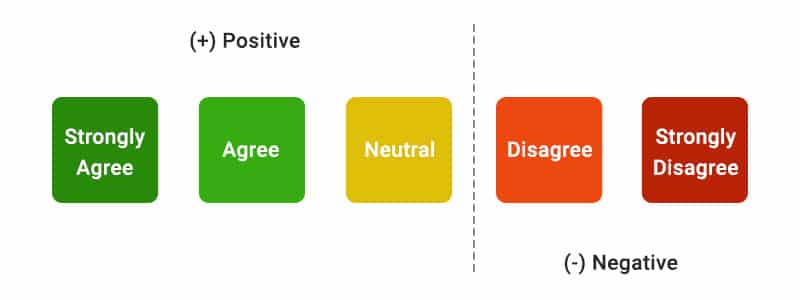
Pleo has the appearance of a small dinosaur and has the size of an average cat. In a study conducted to investigate the effectiveness of robotics in eliminating the barriers to collaboration between people with autism spectrum disorders (ASD) and their therapists, used the Pleo robot platform. Perhaps, alternatives to the assistive technologies have been built into the robot. Users might be using assistive technologies and its compatibility with the robot needs to be considered.
#Five point measure scale agree software
People who have visual disabilities may face accessibility barriers when they try to distinguish and perceive the hardware components of the robot, the software components of robot’s display screen, and any visual signals used by the robot. The participants recommended the importance of aligning the proposed guidelines with safety requirements, environment of interaction (indoor or outdoor), cost and users’ expectations. Moreover, 16 of 17 participants would use the proposed guidelines in their future robot designs or evaluation. Some of them had considered some ad hoc guidelines in their design practice, but none of them showed awareness of or had applied all the proposed guidelines in their design practice, 72% of the proposed guidelines have been applied by less than or equal to 8 participants for each guideline. The majority (15 of 17 participants) agreed that the guidelines are helpful for them to design and implement accessible robot interfaces and applications. The questions act as indicators for each factor. A questionnaire of nine five-point Likert Scale questions and 6 open-ended questions was developed to evaluate the proposed guidelines for developers and designers, in terms of four main factors: usability, social acceptance, user experience and social impact. The guidelines have been evaluated by seventeen HRI designers and/or developers. This research presents a proposal for accessibility guidelines for human-robot interaction (HRI). This is due to the different characteristics of users, as users with visual, hearing, motor or cognitive disabilities were not considered during the design, implementation or interaction phase, causing accessibility barriers to users who have limitations. Unfortunately, currently not all the robots are accessible for all users.

We will increasingly become dependent on automation to support our manufacturing and daily living, and robots are likely to take an important place in this.


 0 kommentar(er)
0 kommentar(er)
